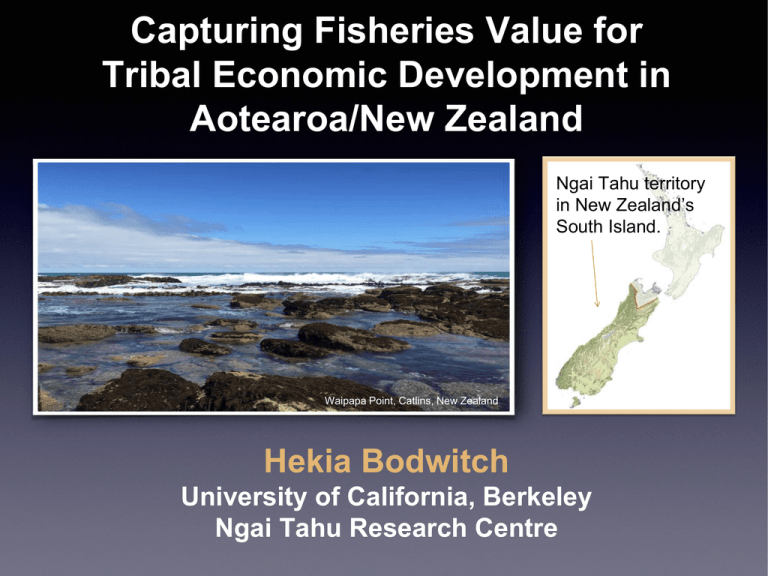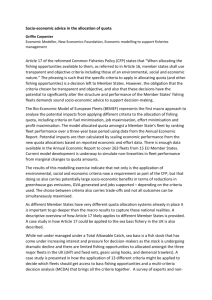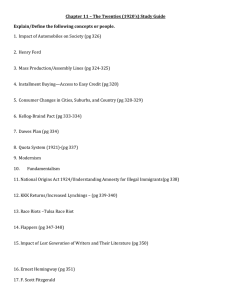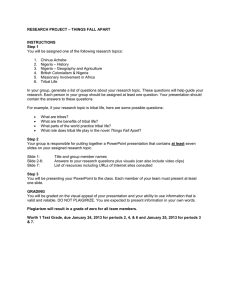Capturing Fisheries Value for Tribal Economic Development in Aotearoa/New Zealand Hekia Bodwitch
advertisement

Capturing Fisheries Value for Tribal Economic Development in Aotearoa/New Zealand Ngai Tahu territory in New Zealand’s South Island. Waipapa Point, Catlins, New Zealand Hekia Bodwitch University of California, Berkeley Ngai Tahu Research Centre Tribes in New Zealand look like mini developing countries with highly enforceable property rights. Ngai Tahu investment properties. Ngai Tahu fishing community. Ngai Tahu is a $1 billion Maori coastal tribe with high unemployment for tribal members, many former fishers. Problem Most tribal fishers did not receive quota and can no longer fish commerically. The tribe obtained commercial quota rights in 2004. Ngai Tahu fisher dispossessed in quota allocation. Ngai Tahu tribal headquarters, Christchurch, NZ. How should tribes manage commercial fishing rights? Should you lease quota to highest bidder or allocate to tribal members? My task Examine how tribe can obtain maximum value for fishing rights by identifying barriers to value creation in fish supply chain. Value in fish supply chains comes from: 1. Production – enforceable rights and ability to harvest fish. 2. Technology – increased efficiency through fishing & processing technologies. 3. Markets – access and information transfer about supply chain to consumer. Main message Processor-lease models disincentive maximum value creation for fish, fisher-held quota allocation models do not. Preview 1. Outline processor-lease model & factors dis-incentivizing value creation. 2. Outline fisher-held quota model & factors that incentivize value creation. 3. Introduce case-study example of fisher-held quota model. (1) Lease model. Tribal quota owners Most tribal quota is leased in packages to fish processing companies who lease it on to fishers. Fishing Rights Market Access Tribal seafood company Fishing Rights Overseas Importer Fish processing company Fishing Rights Processed fish Fresh fish Tribal fisher (1) Lease model rationale. Tribal quota owners For tribes, leasing quota in packages ensures quota in small share holdings and quota for hard to access species is fished. Fishing Rights Tribal seafood company For processors, leases override aggregation limits and package exports ensure low-value fish is sold. Fishing Rights Fish processing company For fishers, fishing with a big company ensures access to quota to cover by-catch. Fishing Rights Fresh fish Tribal fisher (1) Obstacles to value in lease model. Tribal quota owners In lease model, fish is aggregated and sold, obstructing possibilities for added value through traceability. Technology and capital transfer to fisher for improved efficiency does not occur, diminishing value. Fishing Rights Tribal seafood company Market Access Fishing Rights Overseas Importer Fish processing company Fishing Rights Processed fish Fresh fish Tribal fisher Fisher leasing quota must land to company and has little negotiating power. (1) Obstacles to value in lease model. Fish processing company Fisher operates as share-cropper for fishing company, does not receive sufficient capital for technological improvements. Fishing Rights Fresh fish Tribal fisher Fisher receives $1-2/kg from quota holding processor. Ngai Tahu flounder fisher. Fisher’s flounder selling locally for $10/kg. (2) Fisher held quota model. Quota for culturally significant species is allocated directly to tribal fishers who can contract directly with overseas companies. Tribal quota owners Fishing Rights Tribal fisher Market Access Fishing & processing technologies Fresh fish International fishing company (2) Value add rationale found in fisher held quota model. Restrictions on quota ownership & fisheries enforcement ensure transparency and consistency in value chain for maximum value realization. Tribal quota owners Fishers with quota rights provide fish to international company with full information transparency. Fishing Rights Tribal fisher International company provides capital and technology to fisher. Market Access Fishing & processing technologies Fresh fish International fishing company (2) Barriers to value add in fisher held quota model. Tribal quota owners Getting quota from Te Runanga risks privileging some at expense of others. Fishing Rights Currently, only culturally significant species are allocated directly. Tribal fisher Fishers lack access to international companies. Market Access Fishing & processing technologies Fresh fish International fishing company (3) Case study example of economic development through fisher-held quota. Eel quota leased to tribal fishers promotes economic development for Ngai Tahu communities. Tribal fishers holding quota negotiate prices with exporters. Tribal fishers employ unemployed tribal members. Tribal fishers provide monitoring data to tribal scientists. Review 1. Lease models are hierarchical with fisher operating as sharecropper. 2. Relationship between international company and fishers with quota is reciprocal. 3. Fisher-held quota promotes regional economic development. Conclusion Property rights held by producers who contract with international companies incentivizes highest value for fish in market and to fishers. hekiabodwitch@berkeley.edu Funding Eels prepared traditionally, drying before smoking. NSF Doctoral Dissertation Research Improvement Grant NSF East Asian Pacific Summer Institute Social Science Research Council DPDF UC Berkeley Human Rights Center





